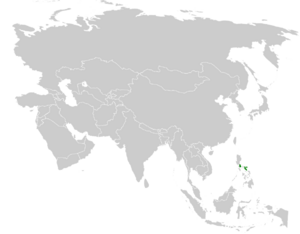Bicol ground warbler facts for kids
Quick facts for kids Bicol ground warbler |
|
|---|---|
| Conservation status | |
| Scientific classification | |
| Genus: |
Robsonius
|
| Species: |
sorsogonensis
|
 |
|
| Synonyms | |
|
Napothera sorsogonensis |
|
The Bicol ground warbler (Robsonius sorsogonensis) is a small bird that lives on the ground. It belongs to the Locustellidae family, which includes many types of warblers. This special bird is found only in the southern parts of Luzon island in the Philippines. It's known for being quite shy and hard to spot, just like its relatives, the Cordillera ground warbler and the Sierra Madre ground warbler. It prefers to live in tropical forests that are wet and low to the ground. Sadly, its home is shrinking because of habitat loss.
Contents
What Does the Bicol Ground Warbler Look Like?
This bird is about medium-sized. It lives on the forest floor, often in areas with rocks. It has a fairly strong body and beak. Its legs are long, and its feet are large.
The Bicol ground warbler is pale underneath. It has a grayish band across its chest. The area under its tail is brown. Look for its white throat and brown upper body. It also has two dotted white bars on its wings. The edges of its wing and tail feathers are reddish-brown. A thin black line looks like a mustache stripe. This bird is easy to recognize! Its song sounds like a very high-pitched "tseeeep soo tseeeep!"
How Was This Bird Discovered?
Two bird experts, Austin L. Rand and Dioscoro S. Rabor, first described the Bicol ground warbler in 1967. They gave it the scientific name Napothera sorsogonensis. At first, they thought it was the same species as the Cordillera ground warbler and Sierra Madre ground warbler.
The name sorsogonensis comes from the province of Sorsogon. This is a place in the Bicol Region of the Philippines. It's where the bird was first found.
Initially, people thought this bird was part of the Old World babblers family, called Timaliidae. They even called it the "grey-banded babbler." But later, scientists learned more about it. They realized it was a warbler, not a babbler. So, its name changed to "Bicol ground warbler." In 2006, an English bird expert named Nigel J. Collar placed it in a new group, or genus, called Robsonius.
Where Does the Bicol Ground Warbler Live?
This bird lives in wet lowland forests. These forests often have large trees called dipterocarp trees. You can find it in forests that have never been cut down. It also lives in forests that are growing back, and at the edges of forests. It can live in areas up to 1,000 meters (about 3,300 feet) high.
The Bicol ground warbler likes to be among limestone rocks. It also enjoys areas with bamboo and rocks covered in moss.
Why Is This Bird "Near Threatened"?
The IUCN (International Union for Conservation of Nature) has listed the Bicol ground warbler as "near threatened." This means it could become endangered soon if we don't protect it. Scientists don't know exactly how many of these birds there are. However, they believe there are likely fewer than 10,000 adult birds left.
The biggest danger to this bird is habitat loss. Its forest home is being cleared away. This happens because of logging (cutting down trees), turning forests into farms, and mining. All these activities are happening where the Bicol ground warbler lives.
What Is Being Done to Help?
The Bicol ground warbler lives in two protected areas. These are the Quezon Protected Landscape and Mount Isarog National Park. But like many places in the Philippines, these areas are not always protected very well.
To help this bird, experts suggest a few things:
- Find out how many birds there are and watch their numbers over time.
- Learn if the bird can survive in forests that have been damaged.
- Figure out all the dangers it faces.
- Make sure the Quezon Protected Landscape and Mount Isarog National Park are better protected.
Images for kids



